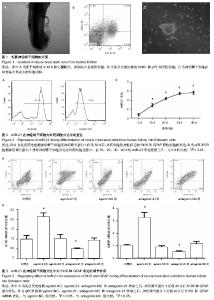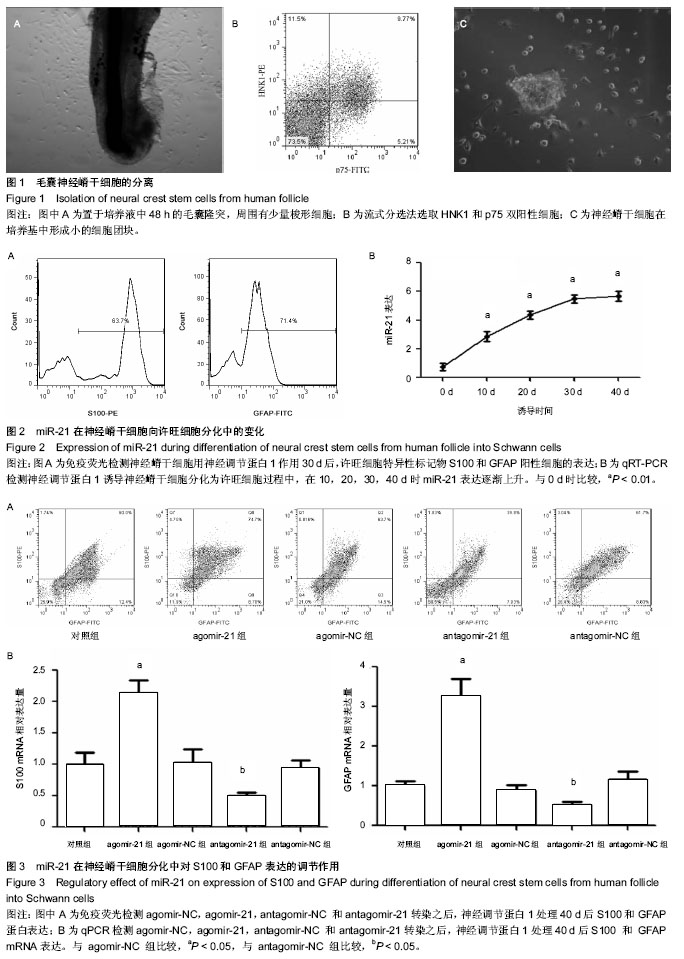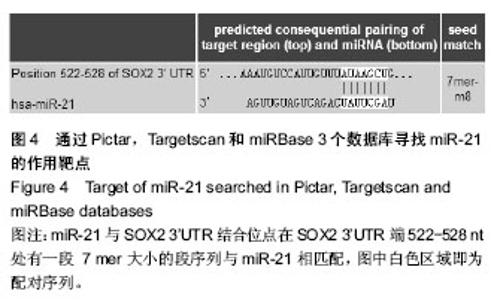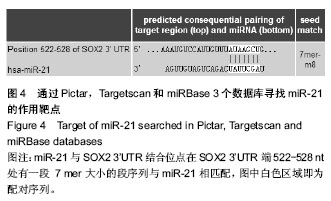| [1] Sieber-Blum M, Grim M.The adult hair follicle: cradle for pluripotent neural crest stem cells.Birth Defects Res C Embryo Today. 2004;72(2):162-172.
[2] Liu X, Song L, Liu J,et al.miR-18b inhibits TGF-β1-induced differentiation of hair follicle stem cells into smooth muscle cells by targeting SMAD2.Biochem Biophys Res Commun. 2013;438(3):551-556.
[3] Lin H, Liu F, Zhang C,et al.Characterization of nerve conduits seeded with neurons and Schwann cells derived from hair follicle neural crest stem cells.Tissue Eng Part A. 2011; 17(13-14):1691-1698.
[4] Lin H, Liu F, Zhang C,et al.Pluripotent hair follicle neural crest stem-cell-derived neurons and schwann cells functionally repair sciatic nerves in rats.Mol Neurobiol. 2009;40(3): 216-223.
[5] Dugas JC, Notterpek L.MicroRNAs in oligodendrocyte and Schwann cell differentiation.Dev Neurosci. 2011;33(1):14-20.
[6] Yu B, Qian T, Wang Y,et al.miR-182 inhibits Schwann cell proliferation and migration by targeting FGF9 and NTM, respectively at an early stage following sciatic nerve injury. Nucleic Acids Res. 2012;40(20):10356-10365.
[7] Yu B, Zhou S, Wang Y,et al.miR-221 and miR-222 promote Schwann cell proliferation and migration by targeting LASS2 after sciatic nerve injury.J Cell Sci. 2012;125(Pt 11):2675- 2683.
[8] Gokey NG, Srinivasan R, Lopez-Anido C, et al.Developmental regulation of microRNA expression in Schwann cells.Mol Cell Biol. 2012;32(2):558-568.
[9] Yu H, Kumar SM, Kossenkov AV,et al.Stem cells with neural crest characteristics derived from the bulge region of cultured human hair follicles.J Invest Dermatol. 2010;130(5):1227- 1236.
[10] Krej?í E, Grim M.Isolation and characterization of neural crest stem cells from adult human hair follicles.Folia Biol (Praha). 2010;56(4):149-157.
[11] Jiang X, Gwye Y, McKeown SJ,et al.Isolation and characterization of neural crest stem cells derived from in vitro-differentiated human embryonic stem cells.Stem Cells Dev. 2009;18(7):1059-1070.
[12] Yang R, Xu X.Isolation and culture of neural crest stem cells from human hair follicles.J Vis Exp. 2013;(74). doi: 10.3791/3194.
[13] Wu WF. Follicle and melanocyte stem cells, and their application in neuroscience A Web of Science-based literature analysis. Neural Regen Res. 2012; 7(34): 2734-2741.
[14] Liu Q, Spusta SC, Mi R,et al.Human neural crest stem cells derived from human ESCs and induced pluripotent stem cells: induction, maintenance, and differentiation into functional schwann cells.Stem Cells Transl Med. 2012;1(4):266-278.
[15] Kumarswamy R, Volkmann I, Thum T.Regulation and function of miRNA-21 in health and disease.RNA Biol. 2011;8(5): 706-713.
[16] Iliopoulos D, Jaeger SA, Hirsch HA,et al.STAT3 activation of miR-21 and miR-181b-1 via PTEN and CYLD are part of the epigenetic switch linking inflammation to cancer.Mol Cell. 2010;39(4):493-506.
[17] Bornachea O, Santos M, Martínez-Cruz AB,et al.EMT and induction of miR-21 mediate metastasis development in Trp53-deficient tumours.Sci Rep. 2012;2:434.
[18] Liu J, Kern JA.Neuregulin-1 activates the JAK-STAT pathway and regulates lung epithelial cell proliferation.Am J Respir Cell Mol Biol. 2002;27(3):306-313.
[19] Le N, Nagarajan R, Wang JY,et al.Analysis of congenital hypomyelinating Egr2Lo/Lo nerves identifies Sox2 as an inhibitor of Schwann cell differentiation and myelination.Proc Natl Acad Sci U S A. 2005;102(7):2596-2601.
[20] Adameyko I, Lallemend F, Furlan A,et al.Sox2 and Mitf cross-regulatory interactions consolidate progenitor and melanocyte lineages in the cranial neural crest.Development. 2012;139(2):397-410 |



